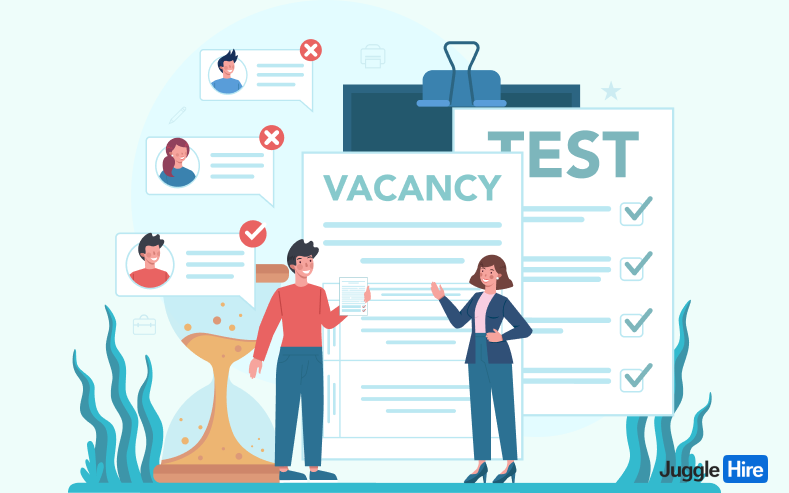8 Proven Hiring Strategies for Small Businesses

Hiring the right people can feel like a huge hurdle for small businesses. With bigger companies often snapping up top talent, it might seem tough to compete.
According to research, 56% of small businesses find it ‘somewhat difficult’ or ‘very difficult’ to find the right employee for their business.
But no worries, with the right strategies, you can attract and keep the skilled employees you need.
This article is here to guide you through 8 proven hiring strategies for small businesses that can help your business thrive. Let’s dive in and turn those hiring challenges into opportunities.
Common Challenges in Hiring for Small Businesses

Small businesses often struggle with hiring because they can’t offer high salaries like big companies. This makes it difficult to attract the best talent. Also, providing competitive benefits such as health insurance and retirement plans is challenging due to their cost.
Small businesses usually receive fewer job applications, limiting their options for finding the right candidates. They need employees who are versatile and can handle multiple roles, which is hard to find.
Another major issue is employee retention. Workers might leave for better opportunities after receiving training, forcing small businesses to restart the hiring and training process.
Additionally, small businesses typically don’t have dedicated HR departments, meaning the business owner must manage hiring along with their other responsibilities.
This limits the time and resources they can devote to recruiting and retaining employees, compounding their hiring challenges.
In the next section, we will provide you with strategies to overcome these issues.
Proven Hiring Strategies for Small Businesses

Hiring for small businesses is not just about filling a vacancy but finding someone who adds value to the team. To navigate the challenges of attracting and retaining talented individuals, adopting effective hiring strategies is key.
These strategies are tailored to help small businesses identify, attract, and secure the best candidates, ensuring they fit both the role and the company culture. The strategies we’ll discuss:
- Defining Your Business Needs
- Crafting Effective Job Descriptions
- Utilizing the Right Hiring Platforms
- Screening and Shortlisting Candidates
- Screening and Shortlisting Candidates
- Making the Decision
- Creating a Welcoming Onboarding Experience
- Retention Strategies for Small Businesses
Now, let’s explore some specific strategies that can make the hiring process more efficient and successful for small businesses.
01. Defining Your Business Needs
For small businesses, every hire must be strategic due to limited resources. Begin by identifying the roles your business needs to fill. This step involves understanding the gaps in your current team and envisioning the skills necessary to move your business forward. Consider not just the immediate needs but also long-term goals.
What skills and experience will contribute to growth? It’s essential to have a clear picture of the role each new hire will play. This clarity ensures you seek candidates with the right mix of skills, experience, and potential for growth.
For example-
Imagine your small web design company values creativity, teamwork, and a flexible approach to problem-solving. You’re looking for a graphic designer who not only has the technical skills but also thrives in a collaborative environment and is adaptable to client needs.
Recognizing the specific needs of your business helps in targeting your search more effectively. It saves you time and resources.
02. Crafting Effective Job Descriptions
Writing clear, attractive job descriptions is crucial. The job posting is often the first interaction potential candidates have with your business. Highlight essential responsibilities and desired qualifications, but also convey the personality of your company.
Discuss your company’s mission, the team environment, and any unique benefits of working with you. Emphasizing company culture attracts candidates who not only have the skills but also share your values and are more likely to be a good fit for your team.
For example-
If you’re hiring for a project manager in your construction firm, the job description could highlight the importance of leadership skills, experience with project management software, and the ability to work under pressure.
Additionally, you could mention your company’s commitment to sustainability and community projects, appealing to candidates who value these principles.
Also, use simple language to ensure the posting is accessible to all candidates. Avoid industry jargon that might deter qualified individuals who are new to the field.
03. Utilizing the Right Hiring Platforms

Choosing the right platforms for posting your job can significantly affect the quality and quantity of applicants.
For example-
For a tech position like a software developer, besides LinkedIn, you might also post on Stack Overflow Jobs or GitHub Careers, where tech professionals frequently visit.
For creative roles, platforms like Behance or Dribbble can help you find talented designers who are actively showcasing their portfolios and looking for work.
Evaluate the success of different platforms for roles similar to what you’re offering. Consider the cost versus the potential return.
Networking remains a powerful tool; attend industry meetups, conferences, and other events to connect with potential candidates in person. Encourage your employees to refer people they believe would be a good match for the company.
Offering incentives for successful referrals can motivate employees to recommend high-quality candidates. Combining these strategies can broaden your reach and improve the chances of finding the right match for your business.
Also Read: Applicant Tracking System Best Practices: 12 Tips for Small Businesses
04. Screening and Shortlisting Candidates

To find the best candidates, start with efficient resume screening. Look for specific skills and experiences that match what the job needs. This helps to quickly narrow down the list of potential candidates.
For example-
Pay attention to their past job roles and achievements that are related to the position you are offering.
After reviewing resumes, consider conducting pre-interview assessments. These could be skill tests relevant to the job or simple tasks that demonstrate their ability to handle job-related challenges.
These assessments give a practical view of the candidate’s abilities and help in further shortlisting candidates for interviews. This step ensures that only the most suitable applicants move forward in the hiring process.
05. Conducting Effective Interviews
Effective interviews are key to understanding candidates better. Structure your interviews to get insightful responses. Start with behavioral questions that ask candidates to describe how they handled specific situations in the past.
For example-
Ask a marketing candidate to describe a successful campaign they ran and how they measured its success.
This helps you gauge their problem-solving and interpersonal skills. Then, use skill-based questions to assess their technical or job-specific knowledge.
This gives a well-rounded view of the candidate’s abilities and how they might perform. Remember to keep the interview focused and on-topic to get the information you need to make a decision.
06. Making the Decision
Choosing the right candidate involves several criteria. Assess if they have the necessary skills and experience for the job. Consider how well they fit with your team’s culture and work style. It’s crucial to include diversity and inclusion in your decision-making process.
A diverse team brings different perspectives and can enhance creativity and problem-solving within your business. Select the candidate who not only meets the job requirements but also adds value to your team’s dynamics and supports your goals for diversity and inclusion.
For example-
Choose a candidate for your sales team who not only has a strong sales background but also demonstrates the ability to work collaboratively in a team-focused environment.
Making a thoughtful decision at this stage can significantly contribute to your team’s success and the overall growth of your business.
Also Read: Remote Hiring Tips: How To Attract, Hire and Retain Remote Employees
07. Creating a Welcoming Onboarding Experience
A good onboarding experience is crucial for new hires. It helps them feel welcomed and prepared for their new role. Start with a clear plan that includes all the steps of the onboarding process. This might include filling out paperwork, training sessions, and meetings with key team members.
Make sure new hires understand what is expected of them and how their work contributes to the company’s goals. Also, introduce them to the company culture right away. Share your business’s values and traditions.
Also, arrange a team lunch on their first day and assign a mentor to guide them through their initial weeks.
Help them connect with their colleagues. This makes new hires feel like part of the team and can improve their job satisfaction and performance.
08. Retention Strategies for Small Businesses
Keeping good employees is important for small businesses. One way to do this is by offering professional development and growth opportunities.
This could be training programs, workshops, or courses that help employees learn new skills and advance in their careers. Recognizing and rewarding employee contributions is also key.
This could be through bonuses, public acknowledgment of their hard work, or opportunities for promotion. Employees who feel valued and see a future with your company are more likely to stay.
These retention strategies help build a loyal and motivated team, which is essential for the success of any small business.
How to Leverage Technology in Hiring
Technology plays a big role in hiring for small businesses. It can make the process more efficient. There are many tools and software that help with different parts of hiring, from finding candidates to interviewing them. Let’s look at how technology can help small businesses hire better.
i) Tools And Software That Can Streamline The Hiring Process
Technology makes hiring easier and faster for small businesses. Many tools and software can help with this. One example is JuggleHire. JuggleHire is a great option for small businesses and helps you manage job postings, track applications, and communicate with candidates all in one place.
This can save you time and keep you organized. Other tools can help with scheduling interviews or testing skills. Using software for hiring means you spend less time on paperwork and more time finding the right person for the job.
ii) The Role Of Social Media In Attracting Talent
Social media is a powerful tool for finding new employees. You can use it to share job openings with a wide audience quickly. It’s also a good way to show what it’s like to work at your company. You can post about company events, achievements, or day-to-day activities.
This can make your company more attractive to potential candidates. They get to see your company culture and might decide they want to be part of your team.
iii) Future Trends In Recruitment Technology
Recruitment technology is always changing. In the future, we might see more use of artificial intelligence (AI) to help match candidates with jobs. This could make finding the right person for a job much quicker.
Virtual reality (VR) might be used for job interviews or to show candidates what working at a company is like. Another trend could be using data analytics to understand what recruitment strategies work best.
These technologies could help small businesses find and hire the right people more efficiently.
Hiring Strategies for Small Business: Wrapping Up
In conclusion, hiring doesn’t have to be a daunting task for small businesses. By understanding your needs, crafting clear job descriptions, using the right platforms, and leveraging technology, you can attract the right candidates.
Remember, a thoughtful onboarding process and strategies for retaining employees are just as important. With these proven strategies, small businesses can build strong teams that drive success.
So, take these tips and start making your hiring process work for you. Your next great hire is out there waiting to be discovered.
